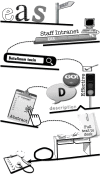A KT intervention including the evidence alert system to improve clinician's evidence-based practice behavior--a cluster randomized controlled trial
- PMID: 24220660
- PMCID: PMC3831589
- DOI: 10.1186/1748-5908-8-132
A KT intervention including the evidence alert system to improve clinician's evidence-based practice behavior--a cluster randomized controlled trial
Abstract
Background: It is difficult to foster research utilization among allied health professionals (AHPs). Tailored, multifaceted knowledge translation (KT) strategies are now recommended but are resource intensive to implement. Employers need effective KT solutions but little is known about; the impact and viability of multifaceted KT strategies using an online KT tool, their effectiveness with AHPs and their effect on evidence-based practice (EBP) decision-making behavior. The study aim was to measure the effectiveness of a multifaceted KT intervention including a customized KT tool, to change EBP behavior, knowledge, and attitudes of AHPs.
Methods: This is an evaluator-blinded, cluster randomized controlled trial conducted in an Australian community-based cerebral palsy service. 135 AHPs (physiotherapists, occupational therapists, speech pathologists, psychologists and social workers) from four regions were cluster randomized (n = 4), to either the KT intervention group (n = 73 AHPs) or the control group (n = 62 AHPs), using computer-generated random numbers, concealed in opaque envelopes, by an independent officer. The KT intervention included three-day skills training workshop and multifaceted workplace supports to redress barriers (paid EBP time, mentoring, system changes and access to an online research synthesis tool). Primary outcome (self- and peer-rated EBP behavior) was measured using the Goal Attainment Scale (individual level). Secondary outcomes (knowledge and attitudes) were measured using exams and the Evidence Based Practice Attitude Scale.
Results: The intervention group's primary outcome scores improved relative to the control group, however when clustering was taken into account, the findings were non-significant: self-rated EBP behavior [effect size 4.97 (95% CI -10.47, 20.41) (p = 0.52)]; peer-rated EBP behavior [effect size 5.86 (95% CI -17.77, 29.50) (p = 0.62)]. Statistically significant improvements in EBP knowledge were detected [effect size 2.97 (95% CI 1.97, 3.97 (p < 0.0001)]. Change in EBP attitudes was not statistically significant.
Conclusions: Improvement in EBP behavior was not statistically significant after adjusting for cluster effect, however similar improvements from peer-ratings suggest behaviorally meaningful gains. The large variability in behavior observed between clusters suggests barrier assessments and subsequent KT interventions may need to target subgroups within an organization.
Trial registration: Registered on the Australian New Zealand Clinical Trials Registry (ACTRN12611000529943).
Figures




Similar articles
-
Improving allied health professionals' research implementation behaviours for children with cerebral palsy: protocol for a before-after study.Implement Sci. 2015 Feb 6;10:16. doi: 10.1186/s13012-014-0202-0. Implement Sci. 2015. PMID: 25889110 Free PMC article.
-
The impact of a small-group educational intervention for allied health professionals to enhance evidence-based practice: mixed methods evaluation.BMC Med Educ. 2019 May 6;19(1):131. doi: 10.1186/s12909-019-1567-1. BMC Med Educ. 2019. PMID: 31060553 Free PMC article.
-
The effectiveness and feasibility of TREAT (Tailoring Research Evidence and Theory) journal clubs in allied health: a randomised controlled trial.BMC Med Educ. 2018 May 9;18(1):104. doi: 10.1186/s12909-018-1198-y. BMC Med Educ. 2018. PMID: 29743051 Free PMC article. Clinical Trial.
-
Knowledge translation strategies used to promote evidence-based interventions for children with cerebral palsy: a scoping review.Disabil Rehabil. 2025 Feb;47(4):827-839. doi: 10.1080/09638288.2024.2360661. Epub 2024 Jun 8. Disabil Rehabil. 2025. PMID: 38850195
-
Effectiveness of Technology-Enabled Knowledge Translation Strategies in Improving the Use of Research in Public Health: Systematic Review.J Med Internet Res. 2020 Jul 31;22(7):e17274. doi: 10.2196/17274. J Med Internet Res. 2020. PMID: 32735231 Free PMC article.
Cited by
-
Development of the Translating Allied Health Knowledge (TAHK) Framework.Int J Health Policy Manag. 2019 Jul 1;8(7):412-423. doi: 10.15171/ijhpm.2019.23. Int J Health Policy Manag. 2019. PMID: 31441278 Free PMC article.
-
Implementation Science Research in Communication Sciences and Disorders: A Scoping Review.Am J Speech Lang Pathol. 2022 May 10;31(3):1054-1083. doi: 10.1044/2021_AJSLP-21-00126. Epub 2022 Feb 1. Am J Speech Lang Pathol. 2022. PMID: 35104415 Free PMC article.
-
Longitudinal evaluation of a knowledge translation role in occupational therapy.BMC Health Serv Res. 2019 Mar 12;19(1):154. doi: 10.1186/s12913-019-3971-y. BMC Health Serv Res. 2019. PMID: 30866911 Free PMC article.
-
Improving allied health professionals' research implementation behaviours for children with cerebral palsy: protocol for a before-after study.Implement Sci. 2015 Feb 6;10:16. doi: 10.1186/s13012-014-0202-0. Implement Sci. 2015. PMID: 25889110 Free PMC article.
-
Evidence-based early rehabilitation for children with cerebral palsy: co-development of a multifaceted knowledge translation strategy for rehabilitation professionals.Front Rehabil Sci. 2024 Aug 7;5:1413240. doi: 10.3389/fresc.2024.1413240. eCollection 2024. Front Rehabil Sci. 2024. PMID: 39169922 Free PMC article.
References
-
- Reddihough DS, Collins KJ. The epidemiology and causes of cerebral palsy. Aust J Physiother. 2003;49:7–14. - PubMed
Publication types
MeSH terms
LinkOut - more resources
Full Text Sources
Other Literature Sources

